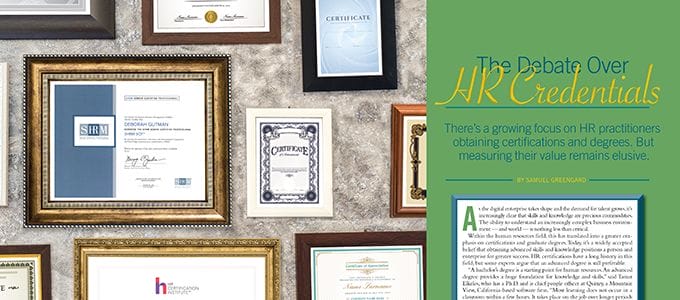An organization may call their head of HR a chief people officer, chief human resources officer, chief talent officer or something else. Whatever the title, the chief people officer has evolved over the years, and they should be aware of the macro trend impacting their role.
This is according to “CHRO Trends 2020,” a report from consulting firm Talent Strategy Group. Researchers produced the report by analyzing Fortune 200 companies and publicly available data. They looked at the 36 new Fortune 200 chief people officers who came into the role in 2019 and identified seven distinct trends. These 36 leaders include UnitedHealth Group’s Patricia Lewis, General Electric’s Kevin Cox, PepsiCo’s Ronald Schellekens and American Express’ Monique Herena.
Chief people officers remain one of the only C-suite roles that is dominated by women rather than men, the report found. Seventy-eight percent of new CHROs were women in 2019, and of all Fortune 200 CHROs, 67.3 percent were women, according to the report. This happened in the same time span in which the CEO role in the Fortune 200 saw a decline in female representation.
FhrFurther, in the pool of CHRO replacements in 2019, a woman replaced a man in 43 percent of the instances compared to 7 percent when a man replaced a woman, noted Zac Upchurch, COO at the Talent Strategy Group and a co-author of the report.
Advanced education is also becoming increasingly important for chief people officers. Compared to 48 percent in 2018, 65 percent of the new CHROs in 2019 hold one or more advanced degrees. Of this majority, 86 percent have earned a master’s degree, and 22 percent have earned a juris doctor.
This tracks with an overall trend for HR managers as well. HR professionals going to business school is becoming more popular, as they can use advanced education to pick up business skills in finance, marketing and operations that they don’t necessarily learn on-the-job as working in HR.
Also read: Tesla’s CHRO Director Pick Points to a New Era
Turnover trends
Another finding from the report was that turnover among chief people officers has increased. In 2019, 19 percent of CPOs turned over, an increase from 16 percent in 2018. In the Fortune 10 alone, the report noted, there were four CHRO replacements in 2019.
Upchurch wouldn’t attribute the higher rate for larger revenue organizations to anything specific. The average tenure of CHROs is a little over five years, he said, and some of them may have just reached their limit in 2019.
CEO turnover rates also likely impacted CHRO turnover rates in 2019, he added. The report found a correlation between the two, and 2019 saw a 40 percent increase in CEO turnover. “The high correlation of CEO and CHRO turnover translates to an increase in CHRO turnover that we expect to continue into 2020,” the report stated.
For example, in November 2019 when McDonald’s CEO Steve Easterbrook was fired after admitting to violating company policy by having a consensual relationship with an employee, Chief People Officer David Fairhurst resigned a day later.
“When the CEO leaves the company, it is very common for it to have a cascading effect. In some cases, other executives leave because they did not get the CEO job and therefore felt passed over. In other cases, they are not aligned with the new CEO and leave to pursue new opportunities. Every executive will now have to switch their personal loyalty to Chris Kempczinski, their new CEO, or consider departing,” said Dave Ramos, chief executive officer of consultancy Shiftpoints Inc., at the time of Fairhurst’s departure.
Upchurch expanded on this logic. A new CEO — especially if they come from outside the company rather than internally — impacts the rest of the executive team, he said.
“I predominantly attribute [this trend] to the changing of the guard and the accumulation of a new strategy,” Upchurch said. “A new CEO [may establish] a new executive team to drive forward strategy, and that strategy is either going to be similar to or differentiated from the previous one.”
Interestingly, while 35 percent of departing chief people officers retired, 31 percent took new or bigger roles within the company, the report noted.
Twelve percent took a lateral move into a business role such as a different executive position. One reason behind this is that some companies see the chief people officer as a stop along the way as someone moves up the company, Upchurch noted. Their ultimate goal may be a different executive role. They may not even have HR experience when they take on the CHRO position. In fact, the 2020 report found that 17 percent of CHROs come into the role with limited to no domain expertise in HR.
Examples of former HR executives who have made these lateral moves in 2019, Upchurch said, include: Jennifer Mann at Coca Cola, who is now senior vice president and president of global ventures; Kathy Gaddes of AmerisourceBergen, who is now chief compliance officer; and Stephanie Lundquist at Target, who is now executive vice president and president of food and beverage.
Also read: The open road potential of a data-driven CHRO
Conversations with chief people officers
The creators of the report also spoke to many chief people officers to get an understanding of what they see as the biggest priorities on their agenda. These conversations provided some qualitative data to the Fortune 200 analysis.
A major theme of these interviews was building capability and accountability, Upchurch said. CHROs want the HR function and HR managers to build on their capabilities in order to meet increasing HR standards and to appropriately hold people accountable to these standards
“There’s a lot of good research about the relationship between what we think we hold people accountable for and how drastic it is versus what we actually do. I think a lot of CHROs are clued into that and saying, ‘We have good processes and practices. What we don’t have is how we hold people accountable for these processes and practices, and we need to enable that by providing them the right capability,’ ” he said, citing a 2019 survey that found managers generally don’t hold their employees accountable.
Another trend that emerged from these conversations were the challenges of balancing both short-term and long-term expectations in HR. Short-term tasks include daily or quarterly duties while long-term involves preparing for the future of work and responding to macro trends.
This delicate balance was true before COVID-19 disrupted the workplace and it still holds true now, Upchurch said.
“All this is now more relevant than it ever has been because CHROs are on the front lines of contingency planning and different ways of working [in response] to COVID-19. But they also need to operate their business. So the question is, ‘How do you do both these things at once?’” he said. HR leaders must manage this complicated relationship “between the quarter-by-quarter basis at which organizations operate while also setting up the runway for perpetual, enduring success.”
Also read: An important collaboration: CHROs and legal confront a crisis


